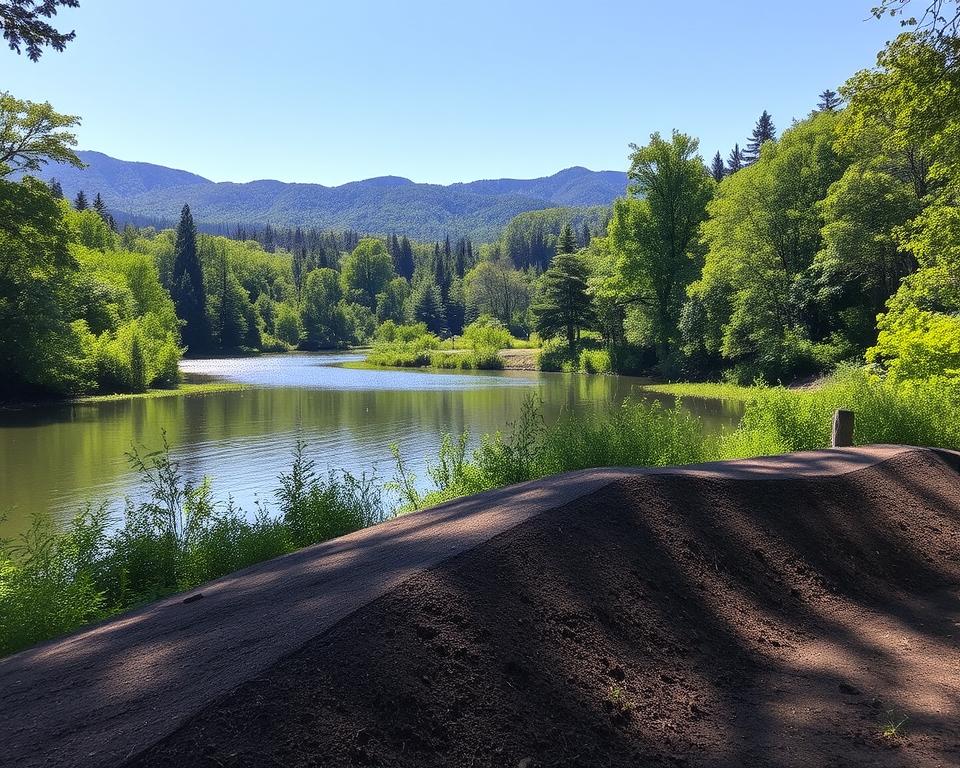Land Clearing in Proximity to Water Sources: Top Methods
Research shows nearly 70% of the earth’s fresh water reserves are endangered due to agricultural drainage and Land Clearing? Such a startling statistic underscores the critical need for responsible land management, essential during water source Land Clearing. Guaranteeing ecological accountability is central to maintaining ecological balance and protecting water quality and animal habitats. As communities face growing demands on resources, adopting sustainable land management practices is indispensable. This approach promotes project success while mitigating soil erosion and minimizing pollution threats in aquatic ecosystems – land clearing services.
Important Discoveries
- Sustainable land management is essential for protecting water quality.
- Embracing optimal practices averts soil erosion and habitat loss.
- Recognizing environmental consequences is vital for responsible Land Clearing.
- Proper planning enhances project success while safeguarding ecosystems.
- Utilizing effective techniques promotes biodiversity in aquatic landscapes.
Grasping the Significance of Sustainable Land Clearing
Land Clearing is not limited to plant removal. It has environmental consequences of Land Clearing that can affect adjacent zones, particularly aquatic ones. Standard techniques frequently result in soil erosion, ecological disturbance, and water pollution. Understanding these effects is crucial to implementing improved land management.
Ecological Effects of Conventional Land Clearing
Standard Land Clearing methods can cause many environmental issues. When vegetation disappears, soil erosion occurs, deteriorating soils and sending sediments into water bodies. This runoff can pollute water bodies, harming aquatic ecosystems. This process puts local wildlife at risk and disturbs ecosystem balance.
Sustainable Land Management Options
Embracing sustainable land management practices addresses issues caused by conventional clearing. Selective clearing—targeted removal of certain vegetation—maintains ecological equilibrium. Applying erosion control tactics, including cover crops, fortifies soils and maintains water quality. Prioritizing native vegetation supports wildlife and improves ecological health.
Top Best Practices for Land Clearing
Successful clearing projects hinge on a solid understanding of ecological factors. Assessing environmental objectives is critical to guarantee clearing efforts are sustainable and impactful. With defined objectives, landowners can make choices that align environmental protection with development priorities.

Assessing Your Environmental Goals
Prior to initiating any clearing work, evaluating environmental goals is vital. This involves evaluating the local ecosystem and how clearing might affect wildlife, soil, and water. Defining personal objectives aids in crafting strategies to safeguard local habitats and watersheds.
Choosing the Right Time for Clearing
Choosing the right time for Land Clearing is critical. Winter to early spring, with frozen conditions, lessens soil disruption and erosion risk. Knowing when to avoid clearing can lead to healthier landscapes and lower environmental impact.
Reviewing Local Regulations and Permits
Compliance with local Land Clearing regulations is critical for any project’s success. Understanding permit requirements can avoid legal issues or fines. Checking ordinances around protected sites ensures compliance and avoids disasters.
Land Clearing Near Aquatic Points: Top Practices
Clearing strategies around aquatic sources emphasize safeguarding sensitive zones and preserving ecological equilibrium. A detailed strategy includes locating sensitive zones and using proper erosion control techniques. Such actions are vital to conserving biodiversity and water quality.
Recognizing Zones Requiring Protection
Before clearing begins, identifying sensitive areas, such as wetlands and riparian buffers, is vital. These unique ecological zones play a vital role in filtering pollutants and providing habitat for various species. Proper identification enables land managers to implement safeguards during and post clearing.
Enforcing Erosion Mitigation Measures
After locating sensitive zones, one should apply robust erosion control to reduce sediment flow into nearby waters. Techniques such as silt fencing, natural buffers, and planting cover crops contribute significantly to maintaining water quality. Integrating eco-friendly clearing with erosion management nurtures healthier aquatic environments. Such practices support environmental health and community well-being.
Mechanical Versus Manual Clearing Techniques
Choosing between mechanical and manual Land Clearing methods is critical. Each approach offers pros and cons regarding environmental impact and process efficiency. Grasping these distinctions aids landowners in choosing strategies that suit their land management objectives.
Mechanical Clearing: Benefits and Drawbacks
Mechanical clearing uses heavy equipment for rapid removal of vegetation and debris. This method accelerates projects and lowers labor demands. Yet, machinery use can cause significant soil disturbance, compaction, and damage to ecosystems.
- Pros: Rapid clearing of expansive zones.
- Reduced labor costs.
- Suitability for challenging terrains.
- Cons: Heightened environmental footprint.
- Possibility of increased erosion.
- Risk of habitat destruction.
Benefits of Manual and Selective Clearing
Manual and targeted clearing emphasize eco-sustainability. They use skilled labor for targeted removal, minimizing soil disturbance and preserving plant species. This approach suits projects where biodiversity and ecosystem health are priorities.
- Benefits: Protection of native flora.
- Minimized soil disruption and erosion.
- Enhanced habitat protection for wildlife.
Wetland Clearing Techniques
Wetland ecosystems are distinctive habitats vital for ecosystem stability. They purify water, mitigate flooding, and serve as habitats for diverse life forms. Comprehending wetland function underpins responsible clearing. The goal is to minimize disruptions and preserve these vital aquatic habitats.
Understanding Wetland Ecosystems
Wetland ecosystems are characterized by their unique hydrology, soil types, and vegetation. They are transitional areas between land and water, hosting diverse fauna. They maintain water quality through filtration systems that eliminate pollutants. Protecting these zones supports biodiversity and strengthens ecosystem resilience.
Techniques for Responsible Wetland Clearing
Thoughtful planning and execution are required for responsible wetland clearing. Eco-conscious strategies lessen clearing’s ecological damage. Some commonly adopted strategies include:
- Staged Clearing: Conduct clearing in phases to minimize ecological disruption, allowing time for wildlife to adapt.
- Selective Clearing: Remove only specific vegetation types, preserving critical species for habitat stability.
- Encouraging Regrowth: Introduce practices that encourage natural vegetation regrowth after clearing, maintaining ecosystem functions.
- Establishing Buffer Areas: Establish buffer areas around sensitive wetland sections to protect aquatic habitats from disturbances.
Using these methods guarantees that wetland clearing respects wetland functions and decreases habitat loss risk.
Protecting Riparian Reserves During Land Clearing
Riparian reserves are crucial for healthy water ecosystems. These areas, located alongside rivers and streams, act as natural buffers. They protect water quality and boost biodiversity. Implementing best practices prevents soil erosion, secures wildlife habitats, and sustains river ecology.
Role of Riparian Buffers in Aquatic Ecosystems
Riparian zones play a vital role in aquatic ecosystems. They filter pollutants, stabilize shorelines, and provide habitats for various species. They serve as barriers that lessen human impact on aquatic systems. By maintaining riparian reserves, water quality improves, and fish and other aquatic life thrive, making ecosystems more resilient.
Best Practices for Maintaining Riparian Zones
Key practices for riparian zone care include:
- Avoid construction within buffer strips to minimize disturbance.
- Use native vegetation to stabilize banks and prevent erosion.
- Establish a diverse plant community to enhance habitat complexity and support wildlife.
- Manage invasive species to protect native plants and maintain ecosystem stability.
- Regularly assess soil health and water quality to guide management efforts.
Significance of Aquatic Land Clearing Strategies
Clearing strategies near water sources ensure ecological balance and water health. Effective water quality management during clearing reduces pollution risks and promotes sustainability. These approaches mitigate sedimentation and enhance aquatic ecosystem health.
Water Quality and Sediment Management Tactics
Ensuring water quality begins by assessing nearby water holdings. Clearing near waters demands preventing sediments that degrade water quality and aquatic fauna. Key strategies include:
- Establishing buffer zones to filter pollutants
- Using sediment traps and barriers to minimize runoff
- Selecting clearing times to coincide with low water levels
These methods protect water quality and maintain ecosystem integrity. Residual vegetation aids in sediment control and nutrient cycling, leading to healthier waterways.
Promoting Biodiversity in Aquatic Landscapes
Preserving biodiversity in water-adjacent landscapes is critical for ecosystem resilience. Water source clearing must conserve native species essential to ecosystems. Steps to boost biodiversity include:
- Conserving critical habitats during clearing processes
- Implementing phased clearing to allow wildlife adaptation
- Restoring natural vegetation post-clearing to enhance habitat
Using these approaches helps land managers cultivate biodiversity in aquatic zones. This leads to more robust and adaptable ecosystems. These efforts safeguard water health and endorse sustainable land-use methods.
Stream Bank and Riverbank Clearing Considerations
Stream bank clearing presents specific challenges that demand ecological and regulatory consideration. Respecting riverbank guidelines is vital to maintain water source ecosystem balance. Addressing erosion, habitat disruption, and water contamination requires targeted solutions.
Obstacles in Stream Bank Clearing
Stream bank clearing faces numerous hurdles. Erosion poses significant risks, leading to soil depletion and declining water quality. Habitat disruption impacts local wildlife, which depend on riparian zones. Without plants, stormwater runoff surges, depositing sediments in watercourses. Such problems underscore the importance of managing stream banks effectively.
Erosion Mitigation and Flora Support
Erosion control is essential in stream bank clearing. Introducing native plants stabilizes stream banks. Roots curtail erosion, supporting a resilient environment for adjacent flora and fauna. Periodic reviews in clearing guarantee efficacy and preserve riverbank ecology. Lush vegetation advances management objectives and sustains ecosystem health.
Wrapping It Up
Applying optimal practices for clearing near water sources is vital for ecosystem health. Stakeholders need to prioritize sustainable land management. This strategy achieves project aims while safeguarding the environment. Careful planning and execution ensure Land Clearing operations safeguard aquatic ecosystems and preserve biodiversity.
Locating sensitive zones and applying erosion controls are fundamental steps. Using mechanical and manual methods enables landowners and contractors to practice responsible land management. Eco-friendly practices promote a balance between human activities and nature. This ensures water sources and adjacent landscapes remain vibrant and resilient.
The commitment to sustainable land management is a collective responsibility. Each step in Land Clearing affects watershed integrity. Integrating eco-responsible practices allows a future of harmonious agriculture and nature.

